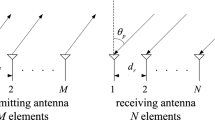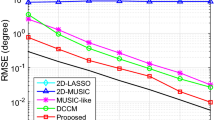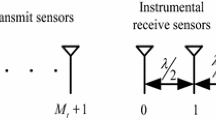Abstract
In order to solve the angle estimation problem of coherent sources under the non-stationary random noise background, an algorithm based on correlation vector Teoplitz reconstruction and oblique projection is proposed. First, transform non-stationary noise into Gauss white noise by correlation vector Toeplitz reconstruction. Then the oblique projection method is used to separate independent and correlated sources. Finally, the conventional algorithm is adopted to estimate the DOA and DOD of bistatic MIMO radar. The algorithm has no loss of array aperture and better angle estimation performance in the case of low signal-to-noise ratio.





Similar content being viewed by others
References
Xiang, C., Feng, D., Lv, H., et al. (2010). Robust adaptive beamforming for MIMO radar. Signal Processing, 90(12), 3185–3196.
Li, J., Xu, L., Stoica, P., et al. (2008). Range compression and waveform optimization for MIMO radar: A Cramer–Rao bound. IEEE Transactions on Signal Processing, 56(1), 218–232.
Kharbech, S., Dayoub, I., Zwingelstein-Colin, M., et al. (2018). Blind digital modulation identification for MIMO systems in railway environments with high-speed channels and impulsive noise. IEEE Transactions on Vehicular Technology, 67(8), 7370–7379.
Zhao, A., Jiang, H., & Li, S. (2018). Improved capon estimators for DOD and DOA estimation in large array MIMO radar: A random matrix method. In 2018 IEEE radar conference (pp. 1140–1145), Nanjing.
Wang, Y., & Li, X. (2018). 3-D imaging based on combination of the ISAR technique and a MIMO radar system. IEEE Transactions on Geoscience and Remote Sensing, 56(10), 6033–6054.
Chen, P., Cao, Z., Chen, Z., et al. (2019). Off-grid DOA estimation using sparse bayesian learning in MIMO radar with unknown mutual coupling. IEEE Transactions on Signal Processing, 67(1), 208–220.
Foroozan, F., Asif, A., & Jin, Y. (2016). Cramer–Rao bounds for time reversal MIMO radars with multipath. IEEE Transactions on Aerospace and Electronic Systems, 52(1), 137–154.
Zhangi, T., Valerio, G., Sarrazin, J., et al. (2017). Wavelet-based analysis of 60 GHz Doppler radar for non-stationary vital sign monitoring. In 2017 11th European conference on antennas and propagation (EUCAP) (pp. 1876–1877). Paris.
Meinl, F., Kunert, M., Blume, H. (2016). Hardware acceleration of maximum-likelihood angle estimation for automotive MIMO radars. In 2016 conference on design and architectures for signal and image processing (DASIP) (pp. 168–175). Rennes.
Kamiya, Y., Kikuma, N., & Sakakibara, K. (2016). DOA estimation of desired signals using in-phase combining of multiple cyclic correlations and spatial smoothing processing. In 2016 international symposium on antennas and propagation (ISAP) (pp. 1028–1029). Okinawa.
Ong, L. T. (2016). Experimental study on spatial smoothing direction of arrival estimation for coherent signals. In 2016 IEEE region 10 conference (pp. 1411–1414). Singapore.
Hui, C., Benxiong, H., & Bin, D. (2007). A modified Toeplitz algorithm for DOA estimation of coherent signals. In Proceedings of 2007 international symposium on intelligent signal processing and communication systems (pp. 80–83). Nov. 28–Dec. 1.
Gong, J., Guo, Y., Yuan, H., et al. (2019). Multi target parameter estimation of monopulse radar based on RJ-MCMC algorithm. Mathematical Problems in Engineering, 2019, 1–9.
Fu, W., Su, T., Zhao, Y., et al. (2011). Joint estimation of angle and Doppler frequency for bistatic MIMO radar in spatial colored noise based on temporal–spatial structure. Journal of Electronics and Information Technology, 33(7), 1649–1654.
Caicai, L., Guisheng, L., & Shengqi, Z. (2010). Research on m-capon method of MIMO radar subarray level. Systems Engineering and Electronics, 32(6), 1117–1120.
Luyou, Z., Yongshun, Z., & Jiahan, X. (2010). A fast T-difference smoothing method for DOA estimation. Modern Radar, 26(2), 57–61.
Funding
This work was supported by the National Natural Science Foundation of China under Grant Nos. 61501501 and 61601502, Aeronautical Science Foundation of China under Grant Nos. 20150196007 and 20160196003.
Author information
Authors and Affiliations
Contributions
JG and YG designed the algorithm scheme. JG performed the experiments and analysed the experiment results. JG, SL and YG contributed to the manuscript drafting and critical revision. All authors read and approved the final manuscript.
Corresponding author
Ethics declarations
Conflict of interest
All authors declare that they have no conflict of interest.
Additional information
Publisher's Note
Springer Nature remains neutral with regard to jurisdictional claims in published maps and institutional affiliations.
Rights and permissions
About this article
Cite this article
Gong, J., Lou, S. & Guo, Y. A Robust Angle Estimation Method for Bistatic MIMO Radar About Non-stationary Random Noise. Wireless Pers Commun 106, 439–450 (2019). https://doi.org/10.1007/s11277-019-06172-w
Published:
Issue Date:
DOI: https://doi.org/10.1007/s11277-019-06172-w




